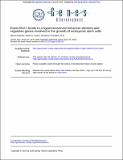Ronin/Hcf-1 binds to a hyperconserved enhancer element and regulates genes involved in the growth of embryonic stem cells
Author(s)
Dejosez, M.; Frampton, Garrett M.; Whyte, W. A.; Stratton, S. A.; Barton, Michelle C.; Gunaratne, P. H.; Zwaka, T. P.; Levine, Stuart S.; Young, Richard A.; ... Show more Show less
DownloadDejosez-2010-Ronin_Hcf-1 binds to.pdf (691.8Kb)
PUBLISHER_CC
Publisher with Creative Commons License
Creative Commons Attribution
Terms of use
Metadata
Show full item recordAbstract
Self-renewing embryonic stem (ES) cells have an exceptional need for timely biomass production, yet the transcriptional control mechanisms responsible for meeting this requirement are largely unknown. We report here that Ronin (Thap11), which is essential for the self-renewal of ES cells, binds with its transcriptional coregulator, Hcf-1, to a highly conserved enhancer element that previously lacked a recognized binding factor. The subset of genes bound by Ronin/Hcf-1 function primarily in transcription initiation, mRNA splicing, and cell metabolism; genes involved in cell signaling and cell development are conspicuously underrepresented in this target gene repertoire. Although Ronin/Hcf-1 represses the expression of some target genes, its activity at promoter sites more often leads to the up-regulation of genes essential to protein biosynthesis and energy production. We propose that Ronin/Hcf-1 controls a genetic program that contributes to the unimpeded growth of ES cells.
Date issued
2010-06Department
Massachusetts Institute of Technology. Department of Biology; Whitehead Institute for Biomedical ResearchJournal
Genes & Development
Publisher
Cold Spring Harbor Laboratory Press
Citation
Dejosez, M., S. S. Levine, G. M. Frampton, W. A. Whyte, S. A. Stratton, M. C. Barton, P. H. Gunaratne, R. A. Young, and T. P. Zwaka. “Ronin/Hcf-1 Binds to a Hyperconserved Enhancer Element and Regulates Genes Involved in the Growth of Embryonic Stem Cells.” Genes & Development 24, no. 14 (July 15, 2010): 1479–1484. © 2010 by Cold Spring Harbor Laboratory Press
Version: Final published version
ISSN
0890-9369
1549-5477